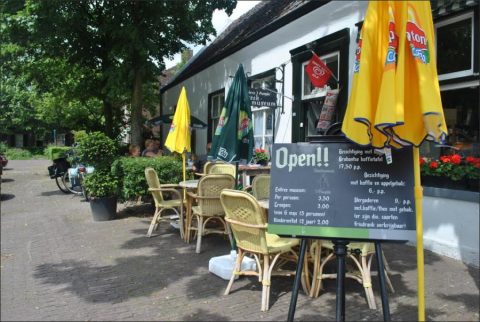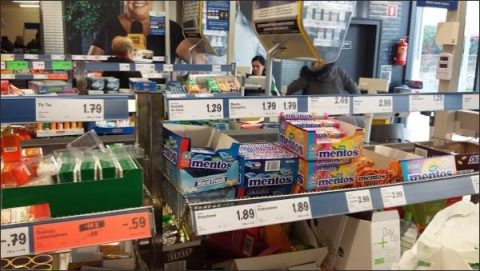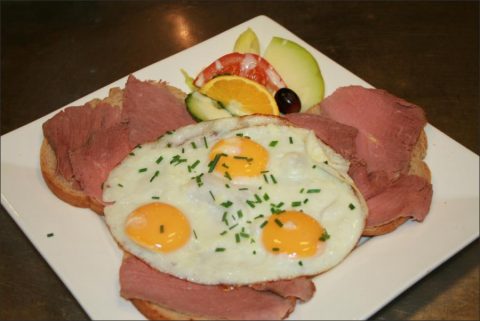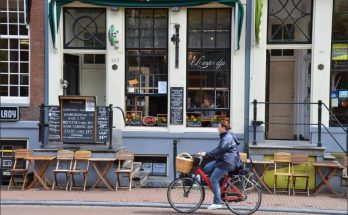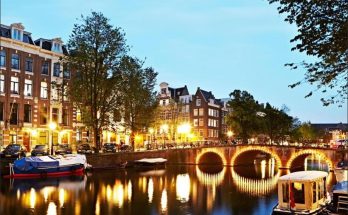A large percentage of the restaurants in Amsterdam include a “koffietafel” on their lunch-time menu, even when they specialize in hot meals. It’s rarely difficult, therefore, to find a “koffietafel,” and it’s also good to remember that a koffietafel is an unusually inexpensive lunch to have.
Typical of what you’ll receive and pay is the koffietafel served at the moderately-priced V.A.M.I. Restaurant, 171 Kalverstraat, in the heart of the shopping section of Amsterdam, for an enormous koffietafel lunch, including a hot meat croquette and milk or coffee. Another koffietafel-serving place? Try the huge Ruteck’s Restaurant, 11 Rembrandtsplein (which is not to be confused with the smaller self-service Ruteck’s at 2 Rembrandtsplein), where the kof-fietafel is referred to by its alternate name, a “twaalfuurtje” (a 12 o’clock bread-lunch), and consists of three pieces of bread, a roll, ham, roast beef, cheese, a currant leaf, a “tid-bit of Italian salad,” and a choice of coffee, tea or milk.
Alternately still, Ruteck’s offers a “Brabantse koffietafel”, which includes all the above items plus an egg, an extra slice of bread, fruit for dessert, and a second glass of coffee or milk. For an even swankier koffietafel, try the one served at the quiet, genteel Formosa Tearoom, 15 Spui (about 20 yards from the Kalverstraat), or the variety of the restaurant at the American Hotel, overlooking the Leidseplein, which offers (from noon to 2 only): an assortment of white, rye, brown and gingerbread, a roll, a bun, rusks and butter, cold meat, a “Ravigote sauce shell” with salad or a hot croquette, Gouda cheese, jam, coffee, tea, milk or chocolate! For a cheaper kometafel, try the one at the restaurant of the Nederlandse Vrouwen-club (Netherlands’ Women’s Club), 580 Keizersgracht; and for still a final koffietafel, go to the restaurant of Gerzon’s Department Store, at 72 Kalverstraat, will bring you the works! And by the way, you eat the koffietafel with a fork and knife.
Sandwich Shops (Broodjeswinkels)
Even more prevalent than the restaurants serving koffietafels are the unusual sandwich shops of Amsterdam (“broodjeswinkels”), where again a large percentage of the population-perhaps a third-take their cold lunches, consisting usually of two or three “broodjes” (sandwiches) and a glass of milk. And if that sounds rather unexciting, then you haven’t tasted a Dutch sandwich!
Prepared on a buttered soft roll, liberally sprinkled with salt, its ingredients consist of a full half-inch to an inch of thinly-sliced (and therefore unusually tender) meat, including some of the most delicious rare roast beef in the world. Or you can have a “broodje tartare”-ground raw hamburger on a soft bun-or a “broodje warme vlees,” which is a hot meat sandwich, covered with a heavy, brown gravy and eaten on a late with fork and knife. The variety of ingredients spread out before you is enormous and appealing, but the most significant aspect of a Dutch sandwich lunch is its cheapness, and only the unusual varieties, or those involving hot meats, rise to the price. Two broodjes and a glass of milk make an excellent, quickly-served lunch-perfect for a fast moving tourist.
Warning: order only one or two broodjes at a time; you’ll be surprised to discover how filling they are. The greatest danger, and worst temptation, to tourists in Amsterdam is overeating!
Where do you find the broodjeswinkels? Everywhere-you can scarcely walk for a block without passing the invitation to enjoy “belegde broodjes” (diverse sandwiches). The most numerous chain of shops is that operated by the brilliantly-named Broodje van Kootje (try pronouncing it), whose broodjes (sandwiches), and whose shops are located at 12 Rembrandtsplein, 20 Leidseplein, and 28 Spui.
The largest of the broodjeswinkels is Van Dobben, at 5 Korte Regu-liersdwarsstraat (just ten yards off the Rembrandtsplein), but the one with the largest and most attractive selection of ingredients is- to my mind-the Plein 24, at 24 Leidseplein, but with slightly higher prices than the rest. Another unusually good sandwich shop-where you will always find hot meat sandwiches with gravy, along with the other varieties-is a place that is simply called (in English) the “Sandwich Shop,” and which stands on the Pijlsteeg, a tiny alley that runs alongside the Hotel Krasnapolsky, directly off the Dam Square. A typical Frommer feast, that leaves me perfectly well filled: one broodje warme vlees with gravy, plus 2 glasses of milk. Never overeat! You’d be well advised to drink the superb Dutch milk, which is consumed in staggering quantities in Holland-perhaps another explanation for the long life spans of the Dutch!
Uitsmijters
Another item offered at most sandwich shops and restaurants- and which many Amsterdammers consume for lunch-is an “uit-smijter” (pronounced “out-smay-ter,” it means “bouncer”), a plate consisting of two buttered slices of bread, topped with either ham or roast beef, atop which is then a fried egg or two! You’ll learn very quickly that it is unusually filling (consumed with a glass of milk)-and very, very cheap. Places serving uitsmijters: virtually every sandwich shop in town, plus the big Ruteck’s Restaurant, 11 Rembrandtsplein (uitsmijter for 1.85 guilders, service included); the A.T.V.A. Restaurant (a Y.M.C.A.-type establishment) at 290 Marnixstraat; the restaurant of the American Hotel, 28 Leidseplein; The V.A.M.I. Restaurant, 171 Kalverstraat; many others.
Bami Goreng, Nasi Goreng
And now, lest we leave the impression that everyone in Amsterdam eats a cold lunch, we’ll turn to an especially popular, noontime warm dish. Although many Amsterdammers have a normal meat-and-potatoes meal for lunch, several thousands of them head instead for an Indonesian or Chinese-Indonesian restaurant and order a heaping plate of “bami goreng” or “nasi goreng.” While these items are available for dinner, too, they carry a much lower price tag at lunch, when they are consumed in great quantity. Indeed, in a few dozen restaurants, you can have a three-course bami goreng or nasi goreng meal (starting first with chicken soup—”kippensoep”; then an eggroll—”loempia”; then the bami goreng or nasi goreng)!
And what are these strangely-named concoctions? In their purest Indonesian state, “bami goreng” is a heaping plate of buttered noodles mixed with little strips of meat, while “nasi goreng” is a plate of rice with meat. But the Dutch have added other embellishments: a fried egg atop the pile, a slice of ham or pork underneath, some crisper noodles along the side, the whole garnished with lettuce and pickles. It tastes better than it sounds, it provides a whopping big meal that you won’t be able to finish, and it is—as we noted —incredibly cheap.
Every Indonesian and Chinese-Indonesian, and even a few Dutch, restaurants serve an inexpensive bami goreng or nasi goreng meal at lunch, and we’ll list a few, categorized according to the area of town in which they’re found. On the Damrak, leading up from the Centraal Station, you’ll discover the Wah Nam Restaurant at 32 Damrak, serving kippensoep (chicken soup), nasi or bami goreng, and coffee at lunch (a more elaborate nasi or bami goreng dinner in the evening).
On the Nieuwendijk, a shopping street that runs parallel to the Damrak, the Djakarta Restaurant, 89 Nieuwendijk, charges few dollars for a four-course nasi or bami goreng meal, as does the Chinese Canton Restaurant, 65 Nieuwendijk, closer to the station. At that point where the Nieuwendijk curves into the Singel, the Restaurant Ton Sing, 1 Singel, for inexpensive a lunch-time nasi or bami goreng (including coffee), but raises the price at night, when a “loempia” (eggroll) and other goodies are added.
On the Damstraat, which runs off the Dam Square, the place to visit is the Insulinde Restaurant, 18 Damstraat, where the lunchtime meal (served only from noon to 3) consists of kippensoep, a loempia, bami or nasi goreng, coffee or tea and costs few dollars.
One block from the Leidseplein, the Far East Restaurant, 5 Lange Leidsedwarsstraat, offers soup and nasi or bami goreng, and is a fine place to have it.
On the Rembrandtsplein, the Indrapoera, 40 Rembrandtsplein, serves a 3-course bami or nasi goreng lunch.
In the area of the Stedelijk Museum, the Restaurant De Orient, 21 Van Baerlestraat, a fairly expensive place.
On the Oude Zijds Voorburgwal, a short walk up from the station, the Restaurant Tai Pang, 47 O.Z. Voorburgwal, serves a three-course b-or-n goreng lunch (including soup, eggroll and coffee).
And finally, for your most numerous collection of restaurants serving this inexpensive specialty, head for the Binnen Bantam-merstraat, fairly near to the railroad station, which forms the heart of Amsterdam’s district of Chinese restaurants. There you’ll find at least four restaurants (including the Ling Nam, 3 Binnen Bantam-merstraat; the Azie, 9 Binnen Bantammerstraat) serving a three-course lunch of this sort.
